The WaterSense Current Summer 2010
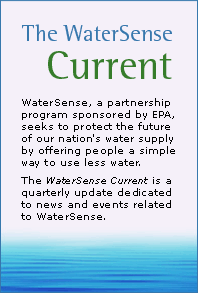
In This Issue:
- Hit the Road With We're for Water!
- WaterSense Labeled Products Reap Savings
- Remodeling? Check for Rebates
- Partner Profile: Brian Vinchesi
- Plumbing Fixture as Art?

Hit the Road With We're for Water!
Be on the lookout this month for a water droplet roving across the United States. Flo, the "spokesgallon" for WaterSense's new We're for Water campaign, is helping roll out this national effort to save water with a classic American road trip. (Don't worry, she won't be driving.) Flo will stop at national landmarks and tourist attractions from Los Angeles to New York City, spreading the word about water efficiency along the way—from July 14 until August 2.
Why a national road trip? In some communities, while the water supply might seem abundant, often that's not the case. Between 1950 and 2005, the U.S. population doubled, while our use of water through public supplies more than tripled. With demand outstripping supply, at least 36 states have projected some degree of water shortage through 2013.
You too can make a difference by joining thousands of your neighbors in supporting the We're for Water campaign and making simple changes to save water at home.
Given that each American uses an average of 100 gallons of water every day at home, it's easy to find a few gallons to spare. Start saving water today with three simple steps: Check. Twist. And replace.

First, check for leaks around your home. Easy-to-fix household leaks can waste enough water each year to fill a backyard swimming pool. To check for silent toilet leaks, just add a few drops of food coloring to the tank and wait 10 minutes before flushing. If any color appears in the toilet bowl, your toilet has a leak. If you find a leak, check out do-it-yourself repair tips or contact a plumbing professional.
Second, twist a WaterSense labeled aerator onto each bathroom faucet to use 30 percent less water without noticing a difference in flow. Faucet aerators can cost a few dollars and save a household more than 500 gallons each year—enough to do 14 loads of laundry. The WaterSense label can give you confidence that your faucet aerator will still perform as well or better than standard models.
Third, replace your old, inefficient showerhead with a WaterSense labeled model, which helps you shrink your water footprint while still enjoying a satisfying shower. Making this switch not only reduces a household's water use by 2,300 gallons annually but also saves enough energy from heating less water to power a television for a year. Accompanying savings on utility bills are an added bonus.
Want to do more? Then take the I'm for Water pledge and become a fan of WaterSense on Facebook to share why you're for water and learn more water-saving tips.
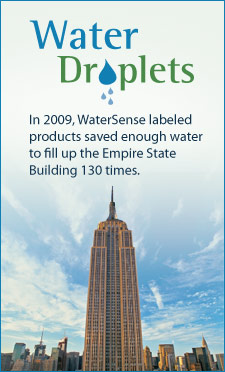
WaterSense Labeled Products Reap Savings
Since the program's inception in 2006, WaterSense has helped consumers save a cumulative 46 billion gallons of water and $343 million in water and sewer bills. In 2009 alone, WaterSense labeled products helped consumers save more than 36 billion gallons of water!
Water wasn't all that the program helped save. Last year WaterSense reduced the amount of energy needed to heat, pump, and treat water by 4.9 billion kilowatt hours of electricity. This helped eliminate about 1.75 million metric tons of greenhouse gas emissions that otherwise would have been released into the atmosphere, equivalent to taking more than 320,000 cars off the road for one year.
Learn more about what WaterSense accomplished in 2009.
Remodeling? Check for Rebates
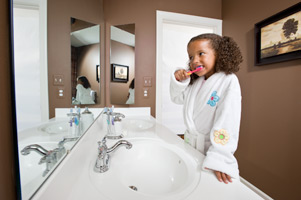
Constructing an additional bathroom is projected to be the most common home remodeling project in 2010, beating out the traditional favorites of remodeling existing bathrooms and kitchens, according to the website Remodelormove.com![]() . If you're one of the multitude of homeowners stirring up dust this summer, consider a no-sweat way to save money on your home renovation: pick the right plumbing products.
. If you're one of the multitude of homeowners stirring up dust this summer, consider a no-sweat way to save money on your home renovation: pick the right plumbing products.
Advances in plumbing technology and design mean that faucets, showers, and toilets can use significantly less water than standard models while still delivering the rinse, spray, and flush you expect. Just look for the WaterSense label when selecting plumbing fixtures for your new or remodeled bathroom, and you can be assured that the products have been independently tested and certified to save water and perform well. More than 2,500 different models of WaterSense labeled plumbing fixtures are available in a wide variety of styles, colors, and price points to help you save water and money.
Because bathrooms are by far the largest water users in the home, accounting for more than half of all the water that families use indoors, giving your bathroom a high-efficiency makeover can help your household save in more ways than one:
- Money: $60 in utility bills annually—enough that the fixtures will pay for themselves in as little as 2.5 years.
- Electricity: 200 kilowatt-hours annually—enough to run a refrigerator for 2 months.
- Water: 7,000 gallons annually—enough to wash 6 months' worth of laundry.
Calculate how much you can save!
Many water utilities and state governments offer rebates on WaterSense labeled products, creating an added financial incentive for buying smart showerheads and efficient toilets.
Changes we make at home will add up quickly across the country. If one in every 10 American homes upgrades a full bathroom with WaterSense labeled fixtures, it could save about 74 billion gallons of water and about $1.5 billion on utility bills nationwide per year. Check out the WaterSense Dreaming of a Better Bathroom brochure for more information.
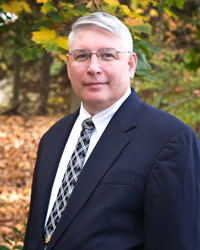
Partner Profile: Brian Vinchesi
The WaterSense Current periodically profiles outstanding WaterSense partners and their achievements in advancing water efficiency and water-efficient products and practices.
As an irrigation design professional for more than 25 years, Brian Vinchesi says he has always been interested in efficient irrigation, a deep-rooted commitment that helped him win a 2009 WaterSense Partner of the Year award. The beauty of efficient irrigation systems, he says, is that they not only use less water, but less energy as well.
Vinchesi's company, Irrigation Consulting, Inc., based in Pepperell, Massachusetts, provides water use and water cost estimates so that clients can see long-term versus short-term costs of a system. With the mercury rising outside, here are Vinchesi's pointers for water-efficient landscaping and irrigation in the summer heat:
WaterSense: What is the most important advice you have for gardeners and homeowners who want to have a lush yard this summer but don't want to waste water in the process?
Brian: You need to properly schedule your watering by understanding when your landscape needs water. Visually check your lawn and plants for signs of stress and look at the weather forecast to see if rain is predicted. Measuring rainfall with a simple rain gauge would be beneficial. In order to water efficiently, you also need to have a sufficient soil depth (4 inches minimum; ideally 6 to 8 inches) that utilizes soil with a good capacity to hold water. Soils can be amended with organic matter or, if sandy, by adding silt or clay to increase their water holding capacity. This will allow you to water less frequently and it will promote deeper roots.
WaterSense: Can you have an irrigation system that saves water?
Brian: I believe that all irrigation systems should be efficient and there is no excuse for them to waste water. However, designing the system properly is only a start. They also must be properly installed, operated, and maintained. Efficient irrigation systems are not hard to achieve, although they will cost more money up front as products with additional features are required.
WaterSense: Any special advice for homeowners with an irrigation system on the property?
Brian: Operators of irrigation systems need to understand the rates at which their irrigation systems apply water. Different types of sprinklers apply water at different rates (from as little as 0.2 inches per hour to as high as 2.0 or more inches per hour). In fact, rarely does an irrigation system only have one type of sprinkler so there will be a minimum of two different precipitation rates. Not all the sprinkler zones should be set for the same run-time, and possibly not even to water on the same days. In order to tell the irrigation system how long to operate, it is imperative to know the precipitation rate.
(Editor's note: If any of this sounds confusing or intimidating, consider hiring a WaterSense irrigation partner to install, program, or maintain your irrigation system for you. Find one in your area.)
WaterSense: What about for people who don't have an irrigation system and water with a hose?
Brian: Hose watering is very inefficient as people forget that the hose is on. One way to circumvent this problem is to purchase an inexpensive hose timer that can be set for a specific watering time. Remember to water the lawn in sections, giving the same amount of water or time to each section and adjusting for any sun and shade issues. Do not wait until puddling occurs; this is a sign that overwatering has already taken place.
WaterSense: Any other tips or advice you'd like to pass along?
Brian: Basically, if you want to save water with an automatic irrigation system, two things are essential: first is to change the irrigation schedule seasonally to adjust for varying weather patterns or have a properly installed smart controller, which can do the schedule changes automatically for you. Second, the system must be maintained on a regular basis by checking for proper operation on a weekly or biweekly basis.
WaterSense: What resources (online or otherwise) would you recommend for people who want to learn more about water-efficient landscaping and irrigation?
Brian: There are a number of sites, including irrigation.org![]() , wateright.org
, wateright.org![]() , A4WE.org
, A4WE.org![]() , and, of course, EPA's WaterSense website.
, and, of course, EPA's WaterSense website.
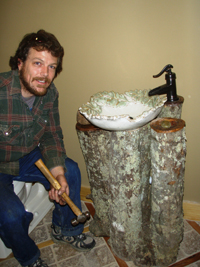
Plumbing Fixture as Art?
A basin in a tree? While it may sound like something from a Dr. Seuss poem, the handiwork of Mat MacDonald, a North Carolina plumber and coppersmith, is perhaps the most innovative use for a WaterSense labeled faucet yet. Mr. MacDonald showcased his tree-trunk vanity design during the Tour of Homes at the National Association of Home Builders' National Green Building Conference in Raleigh, North Carolina, in May 2010.




